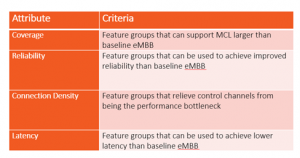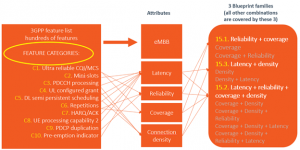Author: Lisa
The Alliance releases Uni5G technology blueprints to guide enterprises deploying private 5G networks
News Highlights:
- Uni5G™ technology blueprints based on 3GPP standards will help enterprises select and implement key features that are relevant to their specific 5G private network deployment.
- The initial set of Uni5G technology blueprints identified three blueprint families focusing on coverage, reliability, connection density, and latency.
- The Alliance is enabling 5G private networks in unlicensed, shared and locally licensed spectrum by providing guidance to enterprises seeking to deploy their own networks. Its board members include Ericsson, Huawei, Intel, Nokia, and Qualcomm.
FREMONT, CA – February 23, 2022 – The Alliance, an international organization dedicated to enabling industry verticals to deploy private cellular networks globally, today announced the completion of the Uni5G technology blueprints. This initial set of three blueprint families provides guidance to industry verticals and enterprises on the key functionalities to implement from 3GPP Release 15 to meet their specific requirements for coverage, reliability, connection density, and latency for their deployment. By focusing and implementing selected features from the Uni5G blueprint families, industry verticals can simplify their path to 5G private networks.
“Globally, there is a growing trend for industry verticals such as manufacturing, warehouses and logistics, ports, and more to deploy 4G and 5G private networks to gain the benefits of increased automation and digitalization,” said Mazen Chmaytelli, president, the Alliance for private networks. “However, these industry verticals are not telecom experts and may not know where to start. By creating the Uni5G technology blueprints that map the 3GPP features they need for the functionality they want, the Alliance is providing a valuable tool for these industry verticals to share with device and equipment manufacturers to obtain the features that are required fulfill their objectives.”
The first Uni5G technology blueprints release includes three blueprint families that map 3GPP features to requirements for coverage, reliability, connection density, and latency. For example, if a shipping port requires reliability and coverage, it can leverage the Uni5G blueprint to understand which features from Release 15 that it needs to implement for either a basic device or an advanced device. The Alliance will continue to evolve the Uni5G technology blueprints to stay in step with 3GPP releases.
The Uni5G technology blueprints are available now to our members. To be notified when the blueprints become available publicly, sign up here.
Caroline Chan, VP Network and Edge Group, GM Network Business Incubation Division of Intel Corporation, said: “This is an important and timely contribution to the global scaling of private network solutions across a range of sectors. These blueprints, when implemented on Intel’s proven FlexRAN reference architecture and Intel Xeon processors, can help enterprises simplify the path to deploy key features for their 5G private networks.”
Stephan Litjens, Vice President, Enterprise Solutions, Nokia Cloud and Networking Services, said: “Successful adoption and use of private wireless 5G by industry is largely dependent on the healthy growth of the 5G device ecosystem and automation enablers. Through its pioneering work on Uni5G blueprints, the Alliance is providing industry with clear guidance on how to achieve this. Uni5G blueprints will be an invaluable tool for verticals and industry players to identify what key features are necessary to optimize and enhance industrial applications that facilitate automation goals.”
Dr. Edward Tiedemann, Senior Vice-President, Engineering, Qualcomm Technologies, Inc., said: “The emergence of 5G private networks is opening up exciting new opportunities for verticals to connect various equipment. It is great to see the Alliance putting in place critical support to demystify the process of deploying 5G private networks—first with the network identifier program and now with blueprints that will help the ecosystem align on requirements for different 5G private network use cases.”
Visit the Alliance at #MWC22
The Alliance for private networks will be showcasing technology solutions in Booth 7B12. To schedule a meeting with our private network experts, contact mfa@nereus-worldwide.com.
Resources:
- Blog: Uni5G technology blueprints – Mapping to 3GPP Release 15
- Website: Uni5G technology blueprints
- Video: Uni5G and MulteFire for Manufacturing Use Case
- Video: Uni5G and MulteFire for Ports Use Case
About the Alliance for private networks
The Alliance is an international organization that is championing the global industry adoption of private networks using MulteFire® specifications for LTE and Uni5G technology blueprints for 5G. With Uni5G or MulteFire, enterprises can efficiently deploy their own optimized, reliable and secure private network in unlicensed, shared or locally licensed spectrum. For more information, visit www.mfa-tech.org.
Uni5G technology blueprints – mapping to 3GPP Release 15
By Asimakis Kokkos, Technical Specification Group Chair
The Alliance is proud to announce the completion of our first set of Uni5G™ technology blueprints based on 3GPP Release 15. These blueprints were developed to help industry verticals deploy their own 5G private networks that are designed specifically to meet their requirements for coverage, reliability, connection density, and latency.
We started this project over a year ago when we partnered with Beecham Research to interview industries operating around the world in a variety of sectors to assess their connectivity requirements. Based on their responses, we were able to identify four attributes that were required beyond baseline enhanced Mobile Broadband (eMBB).

Identify 3GPP Features
The second step was to identify the exact 3GPP features in Release 15 that industry verticals should implement to achieve coverage, reliability, connection density and low latency for their deployment scenario. 3GPP Release 15 has hundreds of features to choose from so this can be an overwhelming task for industry verticals that are not telecom experts. After extensive review, we narrowed down the options to 10 feature categories – with each category including between one and nine features with a total of 35 features.
Mapping Feature Categories to 3GPP Features
The next step was the mapping. We looked at each feature category and mapped the 3GPP features required to support each industry attribute.

What we found in our mapping is that the features that support coverage also improve reliability. And the features that support connection density also reduce latency. So, if an industry vertical wants to ensure that their network deployment will support their connection density requirements, they will also gain the advantage of lower latency.
The mapping resulted in three Uni5G blueprint families.
- Uni5G technology blueprint 15.1 which supports reliability and coverage requirements.
- Uni5G technology blueprint 15.2 which supports latency and density requirements.
- Uni5G technology blueprint 15.3 which supports all requirements.
Within each blueprint family, we also identified a “basic” version and an “extended” version. Each extended version implements a few additional features. This provides industry verticals with the option to purchase and deploy either a basic or high-end device that will work best for them. For example, a port operator can take the Uni5G technology blueprint to their vendor of choice and let them know which features their devices need to implement.
By combing through the hundreds of 3GPP features and identifying just the features needed for private network deployments by industry verticals, MFA is taking the guess work out of the process. With Uni5G technology blueprints, the Alliance is realizing its mission to provide a simplified path to 5G private networks.
Download the Uni5G technology blueprints here.
The Alliance for Private Networks launches Network Identifier Program for enterprises to deploy their own private network
News Highlights:
- The Alliance makes its unique global PLMN ID available to enterprises for their own 5G private network
- The Alliance announces new Private Network Subscriber category for enterprises to jumpstart deployment
FREMONT, CA – November 16, 2021 – The Alliance for Private Networks, an international organization championing the global industry adoption of private networks based upon 3GPP technologies, today announced its Network Identifier Program for enterprises. Enterprises now have access to the our unique global PLMN ID that they can use when deploying their own private network to ensure that only authorized devices connect to their network. The program reduces complexity and streamlines the network development process for enterprises by eliminating the need for them to separately apply for their own PLMN ID.
“Our mission is to make it as easy as possible for enterprises to quickly deploy their own private network and realize the benefits of greater control over their network, enhanced on-premise data security, and predictable performance,” said Mazen Chmaytelli, president, The Alliance for Private Networks. “The Alliance was awarded a unique global PLMN ID by the ITU, and we are creating this new program to ensure all industry verticals have ready access to a PLMN ID that will support their digitalization journey.”
Enterprises and industry verticals including maritime, manufacturing, warehouses, utilities, and venues can select a Private Network ID package or a Neutral Host Network (NHN) ID package that will provide them with all the items they need to deploy a neutral host or private network. For large deployments, enterprises will be able to add-on IDs to meet their requirements for coverage and capacity.
“With access to the global PLMN ID from the Alliance, network suppliers or operators will have the necessary identifiers to create unique and distinguishable private networks, streamlining the deployment process for their enterprise customers – anywhere in the world they are located,” said Asimakis Kokkos, Technical Specification Group Chair and Head of Technology Ecosystems, Nokia Enterprise Solutions.
New Private Network Subscriber category created to jumpstart deployment
The Alliance has also created a new Private Network Subscriber category that will grant enterprises one complimentary Private Network ID package that they can use immediately to deploy their own 5G private network in locally licensed spectrum or MulteFire®/4G private network in unlicensed spectrum today.
“For a one-time fee, Private Network Subscribers gain access to a Private Network ID package that is evergreen and does not need to be renewed,” added Chmaytelli. “Our members also will receive complimentary packages that will meet their deployment requirements. The Alliance wants to help seed as many private networks as possible, and we’re excited to bring this important program to the entire industry.”
To further enable private network deployments, the Alliance, a 3GPP Market Representation Partner (MRP), previously announced that it is also developing Uni5G™ technology blueprints. These blueprints will provide enterprises with practical guidance on implementing the key features from the 3GPP 5G standards that are relevant to their specific deployment. The first blueprints will be finalized in December 2021.
The Network Identifier program is administered by the Certificate Authority and is available today to the Alliance members and non-members. For companies interested in joining the program, visit www.mfa-tech.org.
Resources:
- White Paper: “5G Private Networks for Maritime Use Opportunities for Digital Port Automation,” Beecham Research
- White Paper: “The Importance of Spectrum Liberalization for Private 5G Networks,” ABI Research
- Video: Uni5G and MulteFire Private Networks for Manufacturing
About The Alliance for Private Networks
The Alliance for Private Networks is an international organization that is championing the global industry adoption of private networks using MulteFire specifications for LTE and Uni5G technology blueprints for 5G. With Uni5G or MulteFire, enterprises can efficiently deploy their own optimized, reliable and secure private network in unlicensed, shared or locally licensed spectrum. For more information, visit www.mfa-tech.org.

